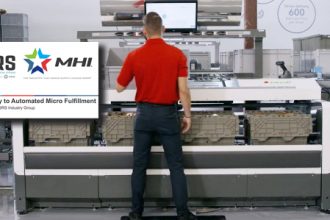
With the substantial growth of e-commerce driving order fulfillment operations to look for different solutions to keep up with single item picking demands — and the proliferation of stock keeping units (SKUs) — more facilities are considering automated solutions, including automated storage and retrieval systems (ASRS).
Indeed, Industry Research, an international market analysis firm, notes in its Warehouse Robotics Market – Growth, Trends and Forecast (2019 – 2024) report, “the presence of a vast number of SKUs is crucial to meet the delivery demands of an immensely large consumer base. Research indicates that more than 50% of the businesses are looking forward to integrate an increasingly high number of inventory SKUs over the forecast period [2019 – 2024], to meet the long tail demands of the consumers by strategically expanding their range of product offering.”
That’s why Industry Research’s analysts expect ASRS to register significant growth in the next five years, saying the systems…
…have the ability to sort, sequence, buffer, and store a wide range of goods into virtually unlimited destinations. Their common applications include goods to a person picking, dynamic replenishment, sequence buffering, order fulfillment, work in process storage, and finished goods storage.
ASRS is a significant component of warehouse automation systems in fulfillment and distribution centers, providing highly efficient, accurate and high throughput inventory management capabilities. They can be configured to be completely redundant, spreading inventory across multiple aisles and thus reducing the dependency on the ability of any single ASRS system to handle a task.
In spite of the report’s prediction, many DC operators erroneously believe ASRS isn’t right for their facility. Here, we dispel four common misconceptions about ASRS.
Misconception # 1: An ASRS is too big for small DCs. Like virtually every piece of material handling equipment, each ASRS is customized to the specific application, including its maximum footprint and height specifications. Every ASRS manufacturer uses standard components to tailor a unique solution that fits the available space, whether that’s inside an expansive suburban facility or a micro-DC in a municipality’s urban core. Further, each type of ASRS (horizontal or vertical carousels, vertical lift modules (VLMs), crane- and shuttle-based ASRS, and goods-to-person buffer systems) automatically determines the optimal storage position for each item it stores. This yields much higher overall storage density, reduces labor requirements in smaller operations, and eliminates the potential ergonomic injury concerns associated with placing and retrieving items at extremely high or low locations.
Misconception # 2: An ASRS is incompatible with oddly shaped items. Not so. In fact, because an ASRS can be configured to handle single item picking for items ranging from jewelry, nuts and bolts to heavy pallet loads in excess of 1,000 pounds, they can easily handle any SKU — regardless of its size or shape.
Misconception # 3: An ASRS won’t integrate with existing software and equipment. Computer-controlled and programmable, ASRS operation is directed by software that interfaces seamlessly with any facility host system, warehouse management system (WMS), warehouse control system (WCS), warehouse execution system (WES), or enterprise resource planning (ERP) system. ASRS solutions providers are highly experienced in ensuring their technology communicates with existing operational systems in order to facilitate high levels of productivity. ASRS also integrates with conveyor to automate item movement through a facility. Further, should business needs change, an ASRS solution can be easily reconfigured or scaled up to expand the system.
Misconception # 4: An ASRS won’t work if the power goes out. If a facility loses power, any equipment that doesn’t run on an alternative power source — lights, conveyor and sortation systems, light-directed picking and more — will all go dark; and DC staffers wouldn’t be able to see to pick from racks. For those who prefer, the ASRS can be backed up with external power generators to guarantee operation in the event of a power failure. As for other reliability and uptime concerns, ASRS solutions providers offer preventive maintenance training and service, as well as 24/7 technical support to ensure the equipment operates efficiently to increase overall productivity.
Have more questions about ASRS and their suitability for your operation? The members of MHI’s Automated Storage/Retrieval Systems (ASRS) group are always available to share information about potential solutions. They recently released a new video that further dispels common misconceptions about the technology, here.



